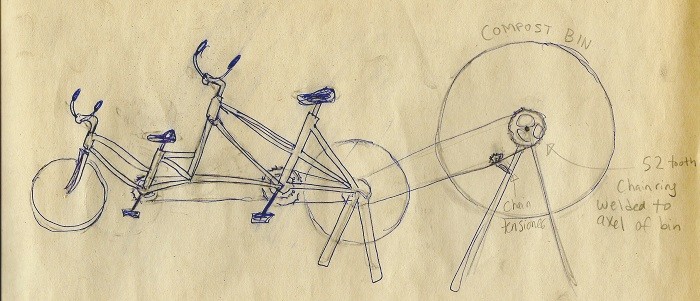
|
|
|
Hansen's Northwest Native Plant Database |
|
|
CompostingMake your own soil amendments for free! |
|||||||||||
|
Turn your yard scraps and household waste into next year's golden dirt. Let nature work for you, and enjoy the finest potting soil ever--free! At right, possibly the world's happiest Deer Fern (Blechnum spicant) in a private Salem, Oregon, garden. It has grown it's whole life in composted soil. |
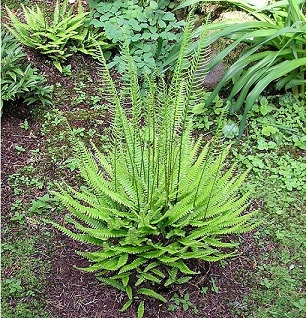 |
||||||||||
|
|||||||||||
| Bins and tools |
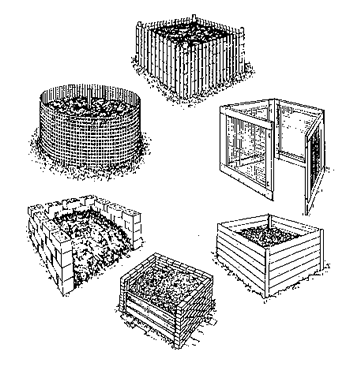 |
||||||||||
|
Compost turners: For those who want compost faster and more fully mixed, there are many tools made specially for this purpose. The first one at right is called Yard Butler and has two flippers which fold up when plunged into the pile and come down when it is raised, stirring the pile from bottom to top. The second one at right is the Double Winged Metal Pile Turner and Compost Aerator. It has similar flippers as the first one but goes farther with a drill-type pointed end and a second handle for added ease in using. If you have a two or three sectioned bin, you can use a digging fork or pitch fork to lift material from the first bin to the second, turning bottoms up as you go. A third section can hold buckets of greens and browns to be added alternately. |

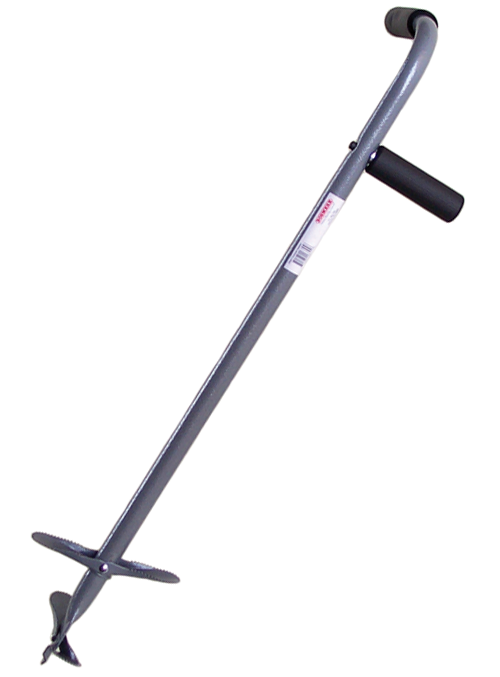 |
||||||||||
|
RIBs (Recycle Ithaca's Bicycles) shows this unique
compost turner:
http://velonet.org/ribs/get-involved/private-programs/ |
RIBs is collaborating with Cooperative Extension to design a fun and interactive compost turning apparatus. The finished product will be a pedal powered compost turner that will be permanently installed in the new plot of land near the farmers market. With the help of local welders, engineers and mechanics, we will be building this stationary tandem bicycle from donated bike parts. | ||||||||||
|
Tumbling compost bins: An alternative to manual mixing is the tumbling or rotating style of bin. There are many designs available. They have a platform of some sort to allow movement. Some have a crank that is either manual or motor driven. Others just rotate in their stand. They come in varying sizes. In this case, bigger is better because more materials can be loaded, allowing a more varied mixture of nutrients=more balanced product. Some thoughts about tumbling bins vs. stationary ready-made bins:
The Suburban Hobby Farmer website has an informative article titled "Do Tumbling Compost Bins Work?" in which he shares his personal experiences using this type of bins. See www.suburbanhobbyfarmer.com/compost-bins/ The Barrel Composter: Besides the two examples of commercially built tumbling bins, another design is very economical, easy to set up and fun for the family (especially the kids). A barrel composter is simply a clean, food grade barrel with a tight fitting lid and holes here and there. Put in the compostables, clamp on the lid, turn on its side and roll around the yard/garden. Some folks claim the barrel must be turned the same direction all the time, but personally I do not see the point of that. This composter is obviously simple to move from one spot to another. Good barrels for this application can be had surprisingly cheap or even free. Retail prices range from $10 - $100 for 55 or more gallon barrels. Rain barrels, pickle barrels, barrels that originally held grain, all are good candidates. The trick is this: this type of barrel is useless to hold rain or pickles or whatever when they crack or get holes in them so they are often discarded. But they are perfect for composting. If you buy a new barrel, you have to make holes in it anyway. Look on www.freecycle.org or similar websites. |
The Back
Porch ComposTumbler has two wheels on the back of the frame so it can be
moved more easily. Made of new (not recycled) materials. Retail price is
$299.
www.compostumbler.com/StoreFront/product/back-porch-compostumbler The Recycled Tumbleweed Compost Tumbler (Composting Bin) Made from 100% recycled plastic. When available, the steel in these legs is made with recycled metal (varies between 17 and 20 percent). Regular price is $199. www.cleanairgardening.com/recycled-tumbleweed-composter.html |
||||||||||
|
Compost bins: This lovely white picket bin has a front section that can be lifted off for mucking about in the materials. |
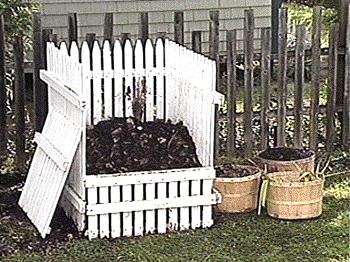 |
||||||||||
| This glamorous bin was built, obviously, by an artist. The painting on the wall sets off the layered shale stones beautifully. |
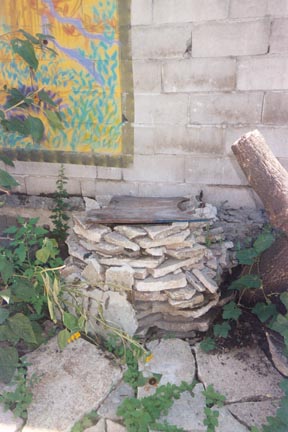 |
||||||||||
| A wattle bin uses sticks from landscape trimmings to form a strong bin from waste material. When the bin itself finally gives up it can be composted in the next bin to come. |
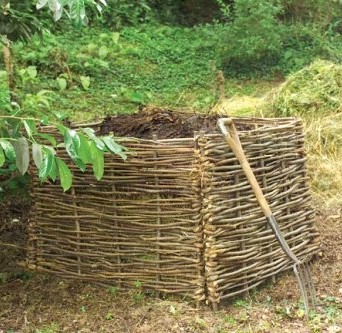 |
||||||||||
| Jeff Yeager used oddments of wood to make this bin. He says: "Composting is the ultimate act of green frugality, turning unwanted organic material into rich humus for use in the garden rather than sealing it in plastic trash bags to spend eternity in a landfill. But for some of us, composting is something even more special – a hobby, a passion, almost a religion. I've even named my beloved compost pile; "Gomer," as in Gomer Pyle (get it?)." Jeff composts: dryer lint, hair and fur, fireplace ashes, jell-o (gelatin), cotton, wool and silk clothing/fabric, full vacuum cleaner bags, nail clippings, rope and string, leather goods and clothing, skunky beer, wine, and corks, pet food leftovers, spoiled milk and dairy products, white glue and masking tape, teabags and coffee grounds, latex condoms and cotton/cardboard feminine hygiene products, cotton balls and q-tips, seaweed/kelp, eggshells, stale bread and other grain products, organic holiday decorations. See www.thedailygreen.com/living-green/blogs/save-money/how-to-compost-anything-0525 |
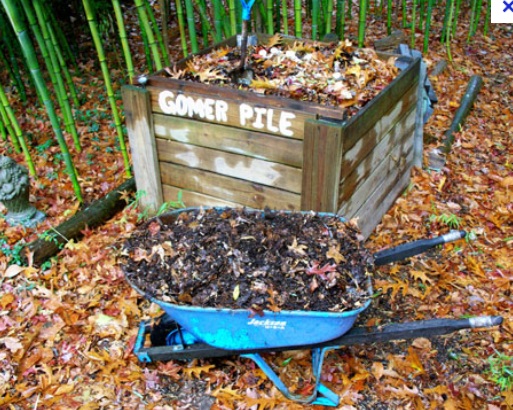 |
||||||||||
| Trench composting: dig a trench in next year's garden plot and put in materials as you have them. Cover with dirt, let rest until next spring when the area can be tilled under. From Home Composting Made Easy, www.homecompostingmadeeasy.com/foodscraps.html |
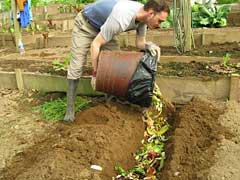 |
||||||||||
|
Bennington County Regional Solid Waste Solutions has
some excellent information about composting in general and also designs
for bins such as this one made of pallets. See
http://bcrcsolidwaste.com/compost.html Photo credit: Tobin |
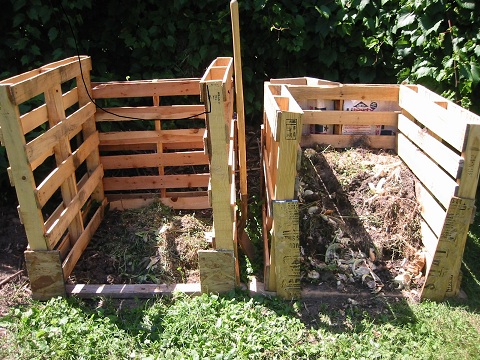 |
||||||||||
| The UW Extension Cooperative Extension's Solid & Hazardous Waste Education Center provides, in their Master Composter Instructor Resources, construction plans for various compost bins such as this handsome and functional bin system for long term use. See www4.uwm.edu/shwec/composter/how-to-build-a-compost-bin.cfm |
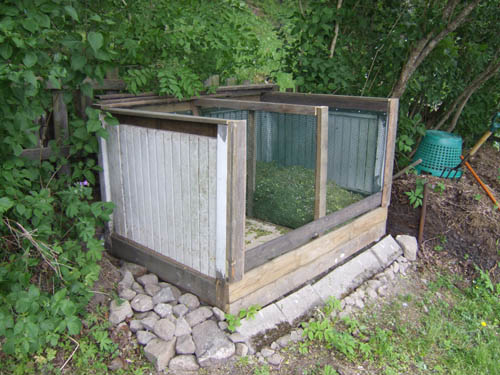 |
||||||||||
|
Composting meats, dairy products, bones, fish Bone meal and fish emulsion have long been recommended as fertilizers for the garden but to make them at home can be tricky. It's not impossible, just requires careful planning. There are composters available that will break down these materials without stinking or drawing scavengers and without much work by the gardener. My personal favorite is the Gedye compost bin. I've used it for years and it has never failed to give complete satisfaction. I compost meat scraps, bones, fish innards--anything! It does not smell, it does not attract varmints, so far it has been indestructible after over 15 years of continuous use. It is made from 100% recycled plastic. Unfortunately it is manufactured in Australia and rarely available in the US. (At the time of this writing, there is one advertised on eBay for $105. The retail price is $85 from the company that makes them.) |
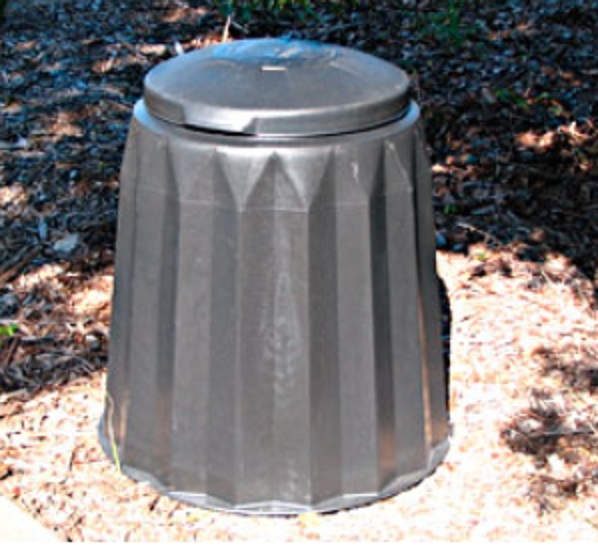 |
||||||||||
|
Compost boosters If you don't want to wait for nature to get your compost going, there are many different kindss of stuff to get your composting off to a good start quickly.
|
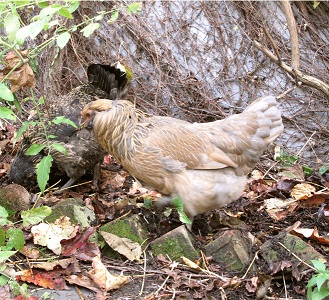 Chicken delivering fresh manure to the compost pile |
||||||||||
|
NW Native Plant Journal articles on composting July 2007, Compost anyone?, pg 17, www.nwplants.com/information/emag/vol5-7.pdf October 2008, Composting for beginners, pg 11, www.nwplants.com/information/emag/vol6-10.pdf April 2007, To do list: caring for your NW native garden, pg 6; Garden products, pg 9, www.nwplants.com/information/emag/vol5-4.pdf |
|||||||||||
|
Composting information on the internet How-to tips: EcoHearth, Come Home to the earth, http://ecohearth.com/eco-zine/food-and-garden/1230-breaking-down-the-bones-how-to-compost-meat-and-other-animal-products.html Detailed instructions: National Geographic Green Living, http://greenliving.nationalgeographic.com/compost-meat-waste-2320.html Ideas from around the world: The International Compost Sanitation Forum and Message Board Home Page, www.jenkinspublishing.com/cgi-bin/messages/discus.cgi?pg=topics Specially designed composters (a bit spendy though): Clean Air Gardening, Environmentally Friendly Lawn & Garden Supplies, www.cleanairgardening.com/how-to-compost-meat.html |
|||||||||||
|